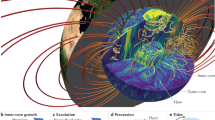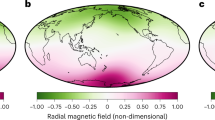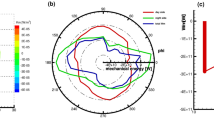Abstract
The Earth’s main magnetic field is thought to be generated by motions in the planet’s fluid outer core, which lead to an effect similar to that of a dynamo1,2,3. Recent high-resolution numerical simulations produce only a non-dipolar4 or a dipolar but comparatively weak magnetic field5,6 unlike that of the Earth. Older models that did generate a strong, Earth-like field needed to use unrealistically high viscosities for the core fluid7,8,9,10. Common to most of the models is the assumption of a laterally uniform core-surface temperature. Here we use a low-viscosity geodynamo model to evaluate the effect of a different and more realistic boundary condition—a uniform heat flux at the surface of the core—on the simulation of an Earth-like magnetic field. Our results show that when the surface temperature is laterally uniform, only a weak magnetic field is generated because planetary-scale fluid circulations are suppressed. In contrast, a laterally uniform heat flux at the core’s surface leads to large-scale convective flows, and a comparatively strong dipole-type magnetic field. Contrary to previous work11,12, we suggest that thermal conditions at the core surface have a strong effect on low-viscosity geodynamo models.
This is a preview of subscription content, access via your institution
Access options
Subscribe to this journal
Receive 12 print issues and online access
$259.00 per year
only $21.58 per issue
Buy this article
- Purchase on Springer Link
- Instant access to full article PDF
Prices may be subject to local taxes which are calculated during checkout


Similar content being viewed by others
References
Buffett, B. A. Earth’s core and the geodynamo. Science 288, 2007–2012 (2000).
Kono, M. & Roberts, P. H. Recent geodynamo simulations and observations of the geomagnetic field. Rev. Geophys. 40, 1013 (2002).
Braginsky, S. I. & Roberts, P. H. Equations governing convection in the Earth’s core and the geodynamo. Geophys. Astrophys. Fluid Dyn. 79, 1–97 (1995).
Kageyama, A., Miyagoshi, T. & Sato, T. Formation of current coils in geodynamo simulations. Nature 454, 1106–1109 (2008).
Christensen, U. R. & Aubert, J. Scaling properties of convection-driven dynamos in rotating spherical shells and application to planetary magnetic fields. Geophys. J. Int. 166, 97–114 (2006).
Takahashi, F., Matsushima, M. & Honkura, Y. Scale variability in convection-driven MHD dynamos at low Ekman number. Phys. Earth Planet. Inter. 167, 168–178 (2008).
Glatzmaier, G. A. & Roberts, P. H. A three-dimensional self-consistent computer simulation of a geomagnetic field reversal. Nature 377, 203–209 (1995).
Kageyama, A. et al. Computer simulation of a magnetohydrodynamic dynamo. II. Phys. Plasmas 2, 1421–1431 (1995).
Kuang, W. & Bloxham, J. An Earth-like numerical dynamo model. Nature 389, 371–374 (1997).
Takahashi, F., Matsushima, M. & Honkura, Y. Simulations of a quasi-Taylor state geomagnetic field including polarity reversals on the Earth Simulator. Science 309, 459–461 (2005).
Busse, F. H. & Simitev, R. D. Parameter dependences of convection-driven dynamos in rotating spherical shells. Geophys. Astrophys. Fluid Dyn. 100, 341–361 (2006).
Kutzner, C. & Christensen, U. R. From stable dipolar towards reversing numerical dynamos. Phys. Earth Planet. Inter. 131, 29–45 (2002).
Braginsky, S. I. & Roberts, P. H. Encyclopedia of Geomagnetism and Paleomagnetism (Springer, 2007).
Glatzmaier, G. A., Coe, R. S., Hongre, L. H. & Roberts, P. H. The role of the Earth’s mantle in controlling the frequency of geomagnetic reversals. Nature 401, 885–890 (1999).
Christensen, U. R. & Olson, P. Secular variation in numerical geodynamo models with lateral variations of boundary heat flow. Phys. Earth Planet. Inter. 138, 39–54 (2003).
Finlay, C. C. & Jackson, A. Equatorially dominated magnetic field change at the surface of Earth’s core. Science 300, 2084–2086 (2003).
Bloxham, J. The expulsion of magnetic flux from the Earth’s core. Geophys. J. R. Astron. Soc. 87, 669–678 (1986).
Olson, P., Christensen, U. R. & Glatzmaier, G. A. Numerical modeling of the geodynamo: Mechanisms of field generation and equilibration. J. Geophys. Res. 104, 10383–10404 (1999).
Kageyama, A. & Sato, T. Generation mechanism of a dipole field by a magnetohydrodynamic dynamo. Phys. Rev. E 55, 4617–4626 (1997).
Sparrow, R. J., Goldstein, R. J. & Jonsson, V. K. Thermal instability in a horizontal fluid layer: Effect of boundary conditions and non-linear temperature profile. J. Fluid Mech. 18, 513–528 (1964).
Hurle, D. T. J., Jakeman, E. & Pike, E. R. On the solution of the Bénard problem with boundaries of finite conductivity. Proc. R. Soc. Lond. A 296, 469–475 (1967).
Takehiro, S., Ishiwatari, M., Nakajima, K. & Hayashi, Y. Linear stability of thermal convection in rotating systems with fixed heat flux boundaries. Geophys. Astrophys. Fluid Dyn. 96, 439–459 (2002).
Roberts, P. H. On the thermal instability of a rotating fluid sphere containing heat sources. Phil. Trans. R. Soc. Lond. A 263, 93–117 (1968).
Sakuraba, A. Linear magnetoconvection in rotating fluid spheres permeated by a uniform axial magnetic field. Geophys. Astrophys. Fluid Dyn. 96, 291–318 (2002).
Roberts, P. H. Kinematic dynamo models. Phil. Trans. R. Soc. Lond. A 272, 663–698 (1972).
Aubert, J. Steady zonal flows in spherical shell dynamos. J. Fluid Mech. 542, 53–67 (2005).
Fearn, D. R. Thermal and magnetic instabilities in a rapidly rotating sphere. Geophys. Astrophys. Fluid Dyn. 14, 103–126 (1979).
Christensen, U. R., Holzwarth, V. & Reiners, A. Energy flux determines magnetic field strength of planets and stars. Nature 457, 167–169 (2009).
Nakagawa, T. & Tackley, P. J. Lateral variations in CMB heat flux and deep mantle seismic velocity caused by a thermal–chemical-phase boundary layer in 3D spherical convection. Earth Planet. Sci. Lett. 271, 348–358 (2008).
Sakuraba, A. & Kono, M. Effect of the inner core on the numerical solution of the magnetohydrodynamic dynamo. Phys. Earth Planet. Inter. 111, 105–121 (1999).
Acknowledgements
Numerical simulations were carried out at the Earth Simulator Center, Yokohama, Japan. A.S. was supported by a grant-in-aid from Yamada Science Foundation. P.H.R. thanks NSF for partial support.
Author information
Authors and Affiliations
Contributions
A.S. constructed the model, carried out numerical analyses and prepared the manuscript. P.H.R. helped with the model and the manuscript.
Corresponding author
Supplementary information
Supplementary Information
Supplementary Information (PDF 282 kb)
Supplementary Information
Supplementary Movie 1 (MOV 4691 kb)
Supplementary Information
Supplementary Movie 2 (MOV 3624 kb)
Rights and permissions
About this article
Cite this article
Sakuraba, A., Roberts, P. Generation of a strong magnetic field using uniform heat flux at the surface of the core. Nature Geosci 2, 802–805 (2009). https://doi.org/10.1038/ngeo643
Received:
Accepted:
Published:
Issue Date:
DOI: https://doi.org/10.1038/ngeo643
This article is cited by
-
Magnesium oxide-water compounds at megabar pressure and implications on planetary interiors
Nature Communications (2023)
-
Scale separated low viscosity dynamos and dissipation within the Earth’s core
Scientific Reports (2018)
-
Magnetic reversals from planetary dynamo waves
Nature (2016)
-
Towards more realistic core-mantle boundary heat flux patterns: a source of diversity in planetary dynamos
Progress in Earth and Planetary Science (2015)
-
Polarity reversals in dependence on the Prandtl number and density stratification
Studia Geophysica et Geodaetica (2015)



